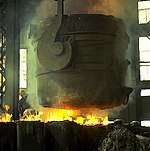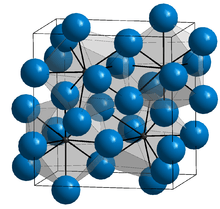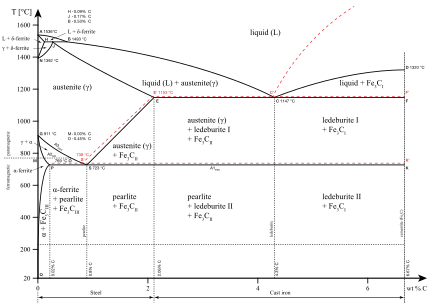Cementite
Cementite (or iron carbide) is a compound of iron and carbon, more precisely an intermediate transition metal carbide with the formula Fe3C. By weight, it is 6.67% carbon and 93.3% iron. It has an orthorhombic crystal structure.[1] It is a hard, brittle material,[1] normally classified as a ceramic in its pure form, and is a frequently found and important constituent in ferrous metallurgy. While cementite is present in most steels and cast irons,[2] it is produced as a raw material in the iron carbide process, which belongs to the family of alternative ironmaking technologies. The name cementite originated from the research of Floris Osmond and J. Werth, where the structure of solidified steel consists of a kind of cellular tissue in theory, with ferrite as the nucleus and Fe3C the envelope of the cells. The carbide therefore cemented the iron.[3]
| Steels and other iron–carbon alloy phases |
|---|
 |
| Microstructures |
| Classes |
| Other iron-based materials |
|
Metallurgy


In the iron–carbon system (i.e. plain-carbon steels and cast irons) it is a common constituent because ferrite can contain at most 0.02wt% of uncombined carbon.[4] Therefore, in carbon steels and cast irons that are slowly cooled, a portion of the carbon is in the form of cementite.[5] Cementite forms directly from the melt in the case of white cast iron. In carbon steel, cementite precipitates from austenite as austenite transforms to ferrite on slow cooling, or from martensite during tempering. An intimate mixture with ferrite, the other product of austenite, forms a lamellar structure called pearlite.
While cementite is thermodynamically unstable, eventually being converted to austenite (low carbon level) and graphite (high carbon level) at higher temperatures, it does not decompose on heating at temperatures below the eutectoid temperature (723 °C) on the metastable iron-carbon phase diagram.
Pure form
Cementite changes from ferromagnetic to paramagnetic at its Curie temperature of approximately 480 K.[6]

A natural iron carbide (containing minor amounts of nickel and cobalt) occurs in iron meteorites and is called cohenite after the German mineralogist Emil Cohen, who first described it.[7] As carbon is one of the possible minor light alloy components of metallic planetary cores, the high-pressure/high-temperature properties of cementite (Fe3C) as a simple proxy for cohenite are studied experimentally. The figure shows the compressional behaviour at room temperature.
Other iron carbides
There are other forms of metastable iron carbides that have been identified in tempered steel and in the industrial Fischer-Tropsch process. These include epsilon (ε) carbide, hexagonal close-packed Fe2-3C, precipitates in plain-carbon steels of carbon content > 0.2%, tempered at 100–200 °C. Non-stoichiometric ε-carbide dissolves above ~200 °C, where Hägg carbides and cementite begin to form. Hägg carbide, monoclinic Fe5C2, precipitates in hardened tool steels tempered at 200–300 °C.[8][9] It has also been found naturally as the mineral Edscottite in the Wedderburn meteorite[10] Characterization of different iron carbides is not at all a trivial task, and often X-ray diffraction is complemented by Mössbauer spectroscopy.
References
- Smith & Hashemi 2006, p. 363
- Durand-Charre 2003
- H. K. D. H. Bhadeshia (2020). "Cementite". International Materials Reviews. 65 (1). doi:10.1080/09506608.2018.1560984.
- Ashrafzadeh, Milad; Soleymani, Amir Peyman; Panjepour, Masoud; Shamanian, Morteza (2015). "Cementite Formation from Hematite–Graphite Mixture by Simultaneous Thermal–Mechanical Activation". Metallurgical and Materials Transactions B. 46 (2): 813–823. doi:10.1007/s11663-014-0228-3.
- Smith & Hashemi 2006, pp. 366–372
- S.W.J. Smith; W. White; S.G. Barker (1911). "The Magnetic Transition Temperature of Cementite". Proc. Phys. Soc. Lond. 24 (1): 62–69. doi:10.1088/1478-7814/24/1/310.
- Vagn F. Buchwald, Handbook of Iron Meteorites, University of California Press 1975
- Gunnar Hägg, Z. Krist., Vol. 89, p 92-94, 1934.
- Smith, William F. (1981). Structure and properties of engineering alloys. New York: McGraw-Hill. pp. 61–62. ISBN 978-0-07-0585607.
- Mannix, Liam (2019-08-31). "This meteorite came from the core of another planet. Inside it, a new mineral". The Age. Retrieved 2019-09-14.
Bibliography
- Smith, William F.; Hashemi, Javad (2006). Foundations of Materials Science and Engineering (4th ed.). McGraw-Hill. ISBN 978-0-07-295358-9.CS1 maint: ref=harv (link)
- Durand-Charre, Madeleine (2004). Microstructure of Steels and Cast Irons. Springer. ISBN 978-3-642-05897-4.CS1 maint: ref=harv (link)
- Mössbauer Spectroscopy of Iron Carbides: From Prediction to Experimental Confirmation

External links
- Crystal structure of cementite at NRL
- Hallstedt, Bengt; Djurovic, Dejan; von Appen, Jörg; Dronskowski, Richard; Dick, Alexey; Körmann, Fritz; Hickel, Tilmann; Neugebauer, Jörg (March 2010). "Thermodynamic properties of cementite (Fe3C)". Calphad. 34 (1): 129–133. doi:10.1016/j.calphad.2010.01.004.
- Le Caer, G.; Dubois, J. M.; Pijolat, M.; Perrichon, V.; Bussiere, P. (November 1982). "Characterization by Moessbauer spectroscopy of iron carbides formed by Fischer-Tropsch synthesis". The Journal of Physical Chemistry. 86 (24): 4799–4808. doi:10.1021/j100221a030.
- Bauer-Grosse, E.; Frantz, C.; Le Caer, G.; Heiman, N. (June 1981). "Formation of Fe7C3 and Fe5C2 type metastable carbides during the crystallization of an amorphous Fe75C25 alloy". Journal of Non-Crystalline Solids. 44 (2–3): 277–286. doi:10.1016/0022-3093(81)90030-2.